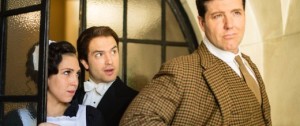The Marriage of Figaro: Stunning, clever production with wit and class

When The Marriage of Figaro, Mozart’s comic opera in four acts, premiered in Vienna at the Burgtheater on May 1, 1786, it was an instant success. Its lively overture and its brilliantly crafted arias, coupled with comical and lovable characters, thrilled the audience. The demand for encores became so numerous that even the emperor had to interfere in order to keep the performance at a reasonable length (he ruled that only parts written for a single voice could be repeated in any opera, although this edict may not have been enforced). The first reviewer wrote that the opera “contains so many beauties, and such a richness of thought as can proceed only from the born genius.”
Opera Lyra’s production of The Marriage of Figaro is not set in 18th-century Spain (as the original), but in turn of the 20th century England. This change in historical period is noticeable mostly in costumes, but as the libretto is suited to any era (with a few small tweaks), it does not hurt the production.
For the last three years, Opera Lyra has been finding its way with more or less success and we waited for 30 months to witness a performance as good and as exciting as La Bohème (September 2012). This time, the task was even harder because of the very characteristic plot in comedic opera (opera buffa) which centers on two groups of characters: a comic group of male and female personages and a pair (or more) of lovers, without much complexity in characters.
The plot is very simple. Susanne and Figaro want to marry, but their employer, Count Almaviva, intends to seduce Susanna, so, naturally, he is trying to prevent the marriage. At the same time, his wife, Countess Almavia contrives with her maid (Susanna) to bring her husband’s love back. Of course, this well-engineered plan is threaten by the teenage page Cherubino, who falls in love with the Countess (as well as in any other skirt in his proximity) and gets in the way. It is up to the cast and director to add colour and meaning through every single note and every move on the stage, to spice up the performance and by doing so, to define the characters. The performers, led by the firm hand of the director, succeed in that perfectly.
Opera Lyra presents an enchanting, swiftly paced, playful evening of music, humour and emotional depth, with a natural flow of events filled with numerous funny turns. Director Tom Diamond skillfully builds the comic elements into hilarious scenes that make you laugh out loud.
While the three baritones, John Brancy (Figaro), James Westman (Count Almaviva), and Peter McGillivray (Dr. Bartolo) held their own vocally, the female artists definitely stole the night!
The audience falls in love with Wallis Giunta’s Cherubino. She truly embodies a young boy whose hormones are in their prime, and wisdom still far away. Young Cherubino is full of energy, lives by hormonal desire and sometimes (but not often) a fear of the possible aftermath. That makes him jumpy, unsettled and hasty, resulting in many comical turns. Giunta is a good singer and even better actress. She introduces funny components by blending movement, body language, and facial expression into an extreme, but likewise believable character- something that is very demanding, especially in comedy, where it is so easy to slip into farce.
Sasha Djihanian found a way to give Susanna a character. In her interpretation, Susanna is not only a charming and spirited girl, but she has wit, imagination, and courage. She is also mischievous, defensive when necessary, and fiercely determined to achieve her goal.
Nathalie Paulin (as Countess Almavia) was heartfelt in her sorrow over the loss of her husband’s love. Still, her skill produced one of the funniest moments in the opera. In a scene full of intensity and jealousy between count and countess, when Susanna comes out of the closet (instead of the expected Cherubino) she sings “Susa – nna.” In that one word and in a split second, she changed the mood from astonishment to casual pleasantness. The natural and subtle way in which she executed this made this moment memorable.
In a very short appearance Johane Ansell as Barbarina also left a lasting impression. Her every word and action fell in the right place and in the right moment, making her performance warm and unaffected.
Mozart’s celebrated comic opera, full of mistaken identity, romance and misadventure, finds its home with the Opera Lyra family. Taken by the impeccable flow of the joyful music and some outstanding performances, the excitement was through the roof, as evidenced by the long standing ovation.
The Marriage of Figaro is on at the NAC until March 28.
The Marriage of Figaro by Wolfgang Amadeus Mozart
An Opera Lyra Ottawa Production
Cast
John Brancy: Figaro
Sasha Djihanian: Susannah
Peter McGillivray: Bartolo
Lynne McMurtry: Marcellina
Wallis Giunta: Cherubino
James: Westman Count Almaviva
Aaron Ferguson: Basilio/Don Curzio
Nathalie Paulin: Countess Almaviva
Sean Watson: Antonio
Johane Ansell: Barbarina
Production Crew
Conductor – Kevin Mallon
Stage Director – Tom Diamond
Chorus Master – Laurence Ewashko
Repetiteur – Judy Ginsburg
Stage Manager – Kelly Luft
One Reply to “The Marriage of Figaro: Stunning, clever production with wit and class”